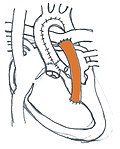Sano shunt
Sano shunt is a medical procedure used in the treatment of congenital heart disease. It is named after the Japanese surgeon who first described it, Shunji Sano.
Overview[edit]
The Sano shunt is a modification of the Norwood procedure, which is used to treat hypoplastic left heart syndrome and other similar conditions. The Sano shunt involves the placement of a conduit from the right ventricle to the pulmonary artery, allowing blood to flow directly from the heart to the lungs.
Procedure[edit]
The Sano shunt procedure is performed under general anesthesia. The surgeon makes an incision in the chest to access the heart. A tube made of synthetic material is then attached to the right ventricle and the pulmonary artery. This tube, or shunt, allows blood to bypass the underdeveloped left side of the heart and flow directly to the lungs, where it can pick up oxygen.
Risks and Complications[edit]
Like all surgeries, the Sano shunt procedure carries some risks. These include infection, bleeding, and complications from anesthesia. There is also a risk of the shunt becoming blocked or failing over time. Regular follow-up appointments with a cardiologist are necessary to monitor the function of the shunt.
Aftercare[edit]
After the Sano shunt procedure, the patient will need to take medications to prevent blood clots and to manage heart function. Regular follow-up appointments with a cardiologist are also necessary to monitor the function of the shunt and to check for any potential complications.
See Also[edit]
References[edit]
<references />
Ad. Transform your life with W8MD's Budget GLP-1 injections from $75


W8MD offers a medical weight loss program to lose weight in Philadelphia. Our physician-supervised medical weight loss provides:
- Weight loss injections in NYC (generic and brand names):
- Zepbound / Mounjaro, Wegovy / Ozempic, Saxenda
- Most insurances accepted or discounted self-pay rates. We will obtain insurance prior authorizations if needed.
- Generic GLP1 weight loss injections from $75 for the starting dose.
- Also offer prescription weight loss medications including Phentermine, Qsymia, Diethylpropion, Contrave etc.
NYC weight loss doctor appointmentsNYC weight loss doctor appointments
Start your NYC weight loss journey today at our NYC medical weight loss and Philadelphia medical weight loss clinics.
- Call 718-946-5500 to lose weight in NYC or for medical weight loss in Philadelphia 215-676-2334.
- Tags:NYC medical weight loss, Philadelphia lose weight Zepbound NYC, Budget GLP1 weight loss injections, Wegovy Philadelphia, Wegovy NYC, Philadelphia medical weight loss, Brookly weight loss and Wegovy NYC
|
WikiMD's Wellness Encyclopedia |
| Let Food Be Thy Medicine Medicine Thy Food - Hippocrates |
Medical Disclaimer: WikiMD is not a substitute for professional medical advice. The information on WikiMD is provided as an information resource only, may be incorrect, outdated or misleading, and is not to be used or relied on for any diagnostic or treatment purposes. Please consult your health care provider before making any healthcare decisions or for guidance about a specific medical condition. WikiMD expressly disclaims responsibility, and shall have no liability, for any damages, loss, injury, or liability whatsoever suffered as a result of your reliance on the information contained in this site. By visiting this site you agree to the foregoing terms and conditions, which may from time to time be changed or supplemented by WikiMD. If you do not agree to the foregoing terms and conditions, you should not enter or use this site. See full disclaimer.
Credits:Most images are courtesy of Wikimedia commons, and templates, categories Wikipedia, licensed under CC BY SA or similar.
Translate this page: - East Asian
中文,
日本,
한국어,
South Asian
हिन्दी,
தமிழ்,
తెలుగు,
Urdu,
ಕನ್ನಡ,
Southeast Asian
Indonesian,
Vietnamese,
Thai,
မြန်မာဘာသာ,
বাংলা
European
español,
Deutsch,
français,
Greek,
português do Brasil,
polski,
română,
русский,
Nederlands,
norsk,
svenska,
suomi,
Italian
Middle Eastern & African
عربى,
Turkish,
Persian,
Hebrew,
Afrikaans,
isiZulu,
Kiswahili,
Other
Bulgarian,
Hungarian,
Czech,
Swedish,
മലയാളം,
मराठी,
ਪੰਜਾਬੀ,
ગુજરાતી,
Portuguese,
Ukrainian



